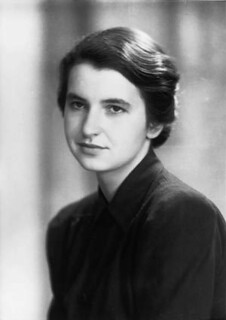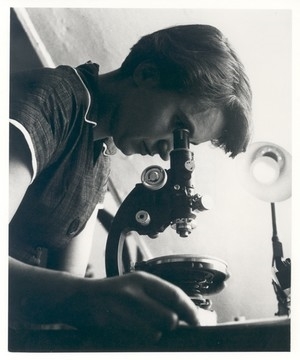 |
| Rosalind Franklin Unknown author / [Public Domain] via Flickr |
April of 1953. This date is when James Watson, Francis Crick, and Maurice Wilkins discovered the substance of all living things, the structure of DNA. This discovery was not left in their hands only (Brenda Maddox). They had help from a very persistent, intriguing, young woman, Rosalind Franklin. Her story, though, does not begin with the controversy over the discovery of DNA.
Rosalind Elsie Franklin was born in London, England on July 25, 1920. She was born into a strict Jewish family that was heavily influenced by her grandfather, Arthur (John Doyle). The time period Rosalind was born into, was very strict and harsh on women. Most people did not believe in women achieving academic success. Especially important people in Franklin’s life like her father. Her father was strongly against the extreme education of women and just wanted Rosalind to be a social worker, but Rosalind was a very persuasive young woman at the age of 15 and was set on being a scientist (Merry Maisel). Her father eventually gave in and enrolled her at Newnham College, Cambridge in 1938 where she graduated in 1941 (Merry Maisel). She remained at Cambridge for a year to work before she quit in 1942 for a job at British Coal Utilization Research Association. Beginning work there she had research on carbon and graphite microstructures. After working there she moved on to the Laboratoire Central des Services Chimiques de L’Etat (Merry Maisel). There is where her controversy began, and also why Rosalind Franklin is my hero.
Rosalind worked for John Randall’s laboratory. Working there is where Rosalind and Maurice Wilkins met. Randall gave Franklin the DNA project, which no one had worked on in months. Randall did not even want Franklin to work on the project, but Franklin was up for the challenge and with the doubt of her peer, Wilkins, she began working on the project. Rosalind was said to have the most beautiful X-ray photos. When Rosalind finally got a clear viewing of DNA under her x-ray, she figured out that DNA had a helical structure and two strands (David Ardell). When Maurice Wilkins found Rosalind’s results he showed it to Watson and Crick. Once Watson seen the picture he knew the exact reasoning and his results were published in a Nature article (David Ardell). Watson did use Rosalind’s findings as a supporting article, but didn’t give her the credit of how he actually solved the puzzle because of her. Even though she was not given the credit she deserved at the time, Rosalind Franklin held her head up and had no hard feelings towards Watson and Crick. She agreed with their results but stayed cautious about most of the details of their model (Merry Miasel). She did, however, move on to J.D. Bernal’s lab at Birkbeck College, where she studied and did work on the tobacco mosaic virus (David Ardell).
 |
| Rosalind Franklin in the lab MRC Laboratory of Molecular Biology / (CC BY-SA 4.0) via Wikimedia |
She remained friendly with Watson and Crick and they all spoke often, until her death in April of 1958 and the age of 37 from ovarian cancer. She died with a well-known reputation around the world for her beneficiation to the structure of carbon compounds and viruses. Following her death, Watson and Crick made it profusely obvious in public lectures that they could not have identified the structure of DNA without her work (David Ardell). Because the Nobel Prize is not awarded to deceased persons, Rosalind Franklin could not be credited for her fundamental role in the discovery of genetic heredity (David Ardell). Although she wasn’t cited for credit at the time it is very clear that she did have an important role in learning the structure of DNA (David Ardell).
Rosalind Franklin is my hero. She was an excellent scientist and very determined woman. Rosalind is exactly the kind of motivation that has encouraged me to keep pursuing new and unsolved things about the world today. When things weren’t going her way and people doubted her she continued on. That’s exactly the kind of person I want to be. Have a positive attitude and love others even when they do you wrong. Franklin was a sweet, kind, and incredibly brilliant scientist. I hope that people will understand and believe how important she was and still is to me and everyone else today.
Page created on 11/3/2011 12:00:00 AM
Last edited 7/20/2020 6:32:10 PM
